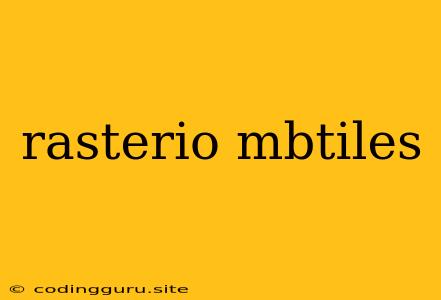Working with Geospatial Data: A Guide to Rasterio and MBTiles
The world of geospatial data is vast and complex, encompassing everything from satellite imagery to topographic maps. Successfully working with this data requires efficient tools and techniques. Two tools that stand out are Rasterio and MBTiles.
What is Rasterio?
Rasterio is a Python library specifically designed for working with geospatial raster data. It provides a comprehensive suite of tools for reading, writing, and manipulating raster datasets, making it a valuable resource for geospatial analysis, image processing, and mapping applications.
What are MBTiles?
MBTiles are a standardized format for storing tiled map data. They are widely used in web mapping applications, providing a compact and efficient way to manage map tiles. The format is a SQLite database that stores each tile as a separate entry, with associated metadata such as zoom level, tile coordinates, and data source.
Why Use Rasterio and MBTiles Together?
Combining Rasterio and MBTiles offers several benefits:
- Efficient Storage: MBTiles provides a compact and efficient way to store raster data, especially when working with large datasets.
- Easy Access: The tiled structure of MBTiles allows for fast access to specific areas of interest, ideal for web mapping applications.
- Data Management: MBTiles offers a structured approach to managing raster data, making it easier to organize and track different datasets.
- Integration with Web Mapping Libraries: MBTiles are compatible with popular web mapping libraries like Leaflet and OpenLayers, simplifying the process of integrating raster data into web applications.
Creating MBTiles from Raster Data Using Rasterio
- Import Necessary Libraries:
import rasterio
from rasterio.merge import merge
from rasterio.enums import Resampling
from rasterio.io import MemoryFile
from mbtiles import Mbtiles
- Read the Raster Data:
with rasterio.open("your_raster_file.tif") as src:
# Read the raster data and metadata
data = src.read()
transform = src.transform
crs = src.crs
bounds = src.bounds
- Create a MBTiles Object:
mbtiles_file = "your_mbtiles_file.mbtiles"
with Mbtiles(mbtiles_file, mode="w") as mb:
# Set the metadata for the MBTiles file
mb.set_metadata(
name="Your Raster Data",
type="baselayer",
description="Raster Data converted to MBTiles",
format="png",
bounds=bounds,
center=[(bounds[0] + bounds[2]) / 2, (bounds[1] + bounds[3]) / 2],
zoom_levels=[0, 10] # Adjust zoom levels as needed
)
- Write Tiles to MBTiles:
for zoom in range(0, 10 + 1):
for tile_x in range(0, 2 ** zoom):
for tile_y in range(0, 2 ** zoom):
# Calculate the bounds for the tile
tile_bounds = rasterio.transform.transform_bounds(
transform, tile_x, tile_y, tile_x + 1, tile_y + 1
)
# Clip the raster data to the tile bounds
with rasterio.open(
"your_raster_file.tif",
bounds=tile_bounds,
transform=transform,
crs=crs,
resampling=Resampling.bilinear, # Adjust resampling method
dtype="uint8", # Adjust data type if needed
) as clipped_src:
# Read and write the tile data to the MBTiles file
tile_data = clipped_src.read()
with MemoryFile() as memfile:
with memfile.open(
driver="PNG",
height=tile_data.shape[1],
width=tile_data.shape[2],
count=1,
dtype="uint8",
transform=transform,
crs=crs,
) as dst:
dst.write(tile_data)
# Add tile to the MBTiles database
mb.add_tile(zoom, tile_x, tile_y, memfile.getbuffer())
This example demonstrates the key steps involved in creating an MBTiles file from raster data using Rasterio. You can further customize this code to accommodate specific requirements for your dataset and application.
Reading and Displaying MBTiles with Rasterio
- Import Necessary Libraries:
import rasterio
from mbtiles import Mbtiles
- Read MBTiles Data:
with Mbtiles("your_mbtiles_file.mbtiles", mode="r") as mb:
# Read tile metadata and data
tile_metadata = mb.get_metadata()
tile_data = mb.get_tile(zoom, tile_x, tile_y)
- Display Tile Data:
# Display the tile data using an appropriate library like matplotlib or OpenCV
This example illustrates how to read tile data from an MBTiles file using Rasterio. You can then use this data to display the tiles in your application or perform further processing.
Conclusion
Rasterio and MBTiles offer a powerful combination for working with geospatial raster data. The efficient storage and retrieval capabilities of MBTiles coupled with the versatile functionality of Rasterio enable seamless integration of raster data into various applications, from web mapping to scientific analysis. Mastering these tools opens doors to a wider range of possibilities in geospatial data management and utilization.
